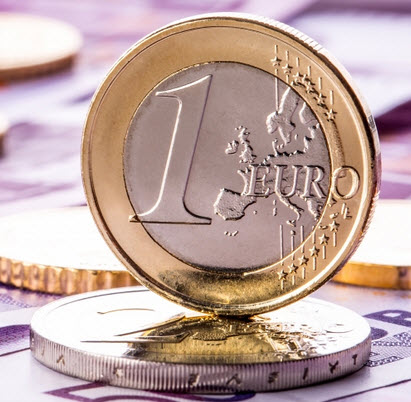In this article:
The Euro is the second-most traded currency on the FX market; only the USD is more frequently traded. The Euro is also the second-most popular currency for national currency reserves.
Most traded currencies in 2018:
| Position | Currency |
| 1 | United States dollar |
| 2 | Euro |
| 3 | Japanese yen |
| 4 | Pound sterling |
| 5 | Australian dollar |
 The EUR/USD is the most frequently traded of all currency pairs, and it accounts for a very large chunk of all the trading that involves the Euro. If we look at the ten most frequently traded currency pairs in 2018, only two of them involves the Euro: EUR/USD on place #1 and EUR/GBP on place #8.
The EUR/USD is the most frequently traded of all currency pairs, and it accounts for a very large chunk of all the trading that involves the Euro. If we look at the ten most frequently traded currency pairs in 2018, only two of them involves the Euro: EUR/USD on place #1 and EUR/GBP on place #8.
- EUR/USD
- USD/JPY
- GBP/USD
- AUD/USD
- USD/CAD
- USD/CNY
- USD/CHF
- EUR/GBP
- USD/MXN
- USD/SGD
Short facts about the Euro
ISO 4217 abbreviation: EUR
Numerical ISO 4217 code: 978
Symbol: €
Central bank: The European Central Bank (ECB) in Frankfurt, Germany
1 Euro = 100 cents
Compared to currencies such as the GBP and USD, the Euro is a very young one. The European Currency Unit (ECU) was launched in 1999, but only as en electronic unit of account. Three years later, the first Euro bills and Euro coins came in use.
Monetary policy
The central bank for the Euro is the European Central Bank (ECB) in Frankfurt, Germany. ECB set and implement the monetary policy for the Eurozone, which is one of the world’s largest monetary areas.
The ECB also have other tasks, such as
- Conduct foreign exchange operations
- Manage the foreign reserves of the European System of Central Banks
- Operate the financial market infrastructure under he TARGET2 payments system
ECB is considered to be one of the most important central banks in the world.
ECB was created by the Treaty of Amsterdam and is one of the seven Institutions of the European Union. ECB is set up in a way that resembles a corporation, since it has shareholders and stock capital. The capital stock is owned by the central banks of the members states. It is non-transferable and can not be used as collateral.
The primary object of the ECB is to maintain price stability within the Eurozone.

Issuing of bills and coins
- Only the European Central Bank (ECB) can issue Euro bills.
- Members states can issue Euro coins, but the amount must be pre-approved by the ECB.
- Certain non-member states have agreements with the ECB that allows them to issue a limited amount of Euro coins.
Where is the Euro official currency?
The Eurozone
The Euro is the official currency for the Eurozone. At the time of writing, the Eurozone encompasses 19 of the 28 European Union members.
- Austria
- France
- Latvia
- Portugal
- Belgium
- Germany
- Lithuania
- Slovakia
- Cyprus
- Greece
- Luxembourg
- Slovenia
- Estonia
- Ireland
- Malta
- Spain
- Finland
- Italy
- The Netherlands
To become a member of the Eurozone, a EU member must meet certain criteria. Simply being a EU members is not enough to qualify for inclusion in the Ethe urozone.
Outside the Eurozone, but still in Europe
- The sovereign European micro-states Monaco, Andorra, San Marino, and the Vatican City have adopted the Euro as their official currency without being members of the Eurozone. They all have special monetary agreements with the European Union and their adoption of the Euro as their official currency is condoned by the EU. They are even allowed to mint a limited number of Euro coins with their own respective national symbol on the obverse side, and such coins are valid throughout the entire Eurozone.
- The sovereign nation Kosovo has unilaterally adopted Euro as its offical currency. It doesn’t have any right to mint Euro coins.
- The sovereign nation Montenegro has unilaterally adopted Euro as its offical currency. It doesn’t have any right to mint Euro coins.
- The Sovereign Base Areas of Akrotiri and Dhekelia on the island of Cyprus is an overseas territory of the United Kingdom, but has adopted the Euro as official currency even though the UK is not a part of the Eurozone.
Far away from Europe
There are three non-sovereign entities outside Europe that have entered into agreements with EU to adopt the Euro as official currency.
- Saint-Pierre-et-Miquelon, located off the Candian coast
- Saint Barthélemy, located in the Carribean Sea
- The Territory of the French Southern and Antarctic Lands
None of them have the right to mint Euro coins.
Inoffical use, semi-official use, etcetera
The Euro is a well-known and well-established currency with a good reputation for stability, and in some countries and regions outside the Eurozone it is widely circulated despite not being an official currency there.
Sometimes, it’s because the country is adjacent to Eurozone countries or receive a lot of visitors from such countries. All the 400+ government-owned liquor stores in Sweden does for instace accept €5, €10, €20, and €50 bills.
Cuba and North Korea are two examples of countries where the offical currency is non-convertible, and where the Euro has been adopted as the official currency for international trading.
In Zimbabwe, the national currency (the Zimbabwean dollar) was suspended by the government in 2009 after a period of hyperinflation. Instead of a national currency, several foreign currencies are utilized, including the Euro.
This article was last updated on: August 8, 2019
